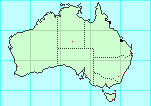

Female 115-123 mm (type 123 mm). Female elongate; wingless species, grey to dark brown with granulated body. Head: with pair of short spines, longer than wide, usually with a pair of spines between eyes, but spines can be reduced in size or absent. Several conspicuous black granulations present; numerous others same color as body. Antennae longer than fore legs. Basal segment much longer and broader than other segments. Thorax: numerous granulations present dorsally and laterally, well spread and often black-tipped. Pronotum with tubercles, central indentation. Mesonotum 6 to 7 times length of pronotum; either plain or sometimes darker on upper half. Metanotum shorter than mesonotum. Abdomen: body granulated. 1st (median segment) and 8th abdominal segments with bold black patch. Black marks also sometimes present centrally on anterior of 2nd segment and elsewhere. 8th-10th segments short; combined length only slightly longer than 7th segment. 6th segment sometimes slightly swollen or broadened posteriorly. Operculum reaching about half-length of anal segment. Rounded supra-anal plate visible. Anal segment subtruncate, slightly rounded at margins. Cerci short. Legs: moderately long and slender, fore femora incurved basally. Femora unarmed. Fore tibiae slightly unevenly broadened, with bold central lobe on outer margin. First segment of fore tarsi also lobed. Hind legs reaching end of 6th abdominal segment. Apex of tibiae and posterior half of tarsi darker. A specimen from north Queensland has the whole of tarsi black. (From Brock, 2000.)
 Eggs have network of large cells on capsule. The conspicuous micropylar
plate is depressed into the egg, hence its shape is not quite oval.
A capitulum is present on a stalk. Capsule lacking depressions.
Length 2.5 mm, height 1.3 mm, width 1.2 mm.
(From Brock, 2000.)
Eggs have network of large cells on capsule. The conspicuous micropylar
plate is depressed into the egg, hence its shape is not quite oval.
A capitulum is present on a stalk. Capsule lacking depressions.
Length 2.5 mm, height 1.3 mm, width 1.2 mm.
(From Brock, 2000.)
Note typical vegetation, e.g. tropical rainforest, temperate rainforest, grasslands, alpine, etc.
 Range:
Range: |
Copyright © 2000-2003
Peter Miller
This page was last changed 20-Sep-2006. |

|

|